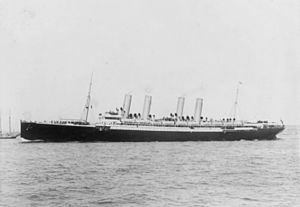RMS Orinoco facts for kids
Quick facts for kids History |
|
|---|---|
| Name | Orinoco |
| Namesake | Orinoco |
| Owner | |
| Port of registry | London |
| Route | Southampton – Caribbean |
| Builder | Caird & Company, Greenock |
| Yard number | 244 |
| Launched | 13 September 1886 |
| Identification | |
| Fate | Scrapped 1909 |
| General characteristics | |
| Type | Ocean liner |
| Tonnage | 4,478 GRT, 2,393 NRT |
| Length | 409.7 ft (124.9 m) |
| Beam | 45.0 ft (13.7 m) |
| Depth | 33.4 ft (10.2 m) |
| Decks | 3 |
| Installed power | 870 NHP, 5,800 ihp |
| Propulsion | triple expansion engine |
| Sail plan |
|
| Speed | 14+1⁄2 knots (26.9 km/h) |
| Capacity |
|
The RMS Orinoco was a British Royal Mail Ship built in Scotland in 1886. She was a large ship that sailed for the Royal Mail Steam Packet Company (RMSP) her whole life. Her main job was to carry mail and passengers between England and the Caribbean. She was taken apart for scrap metal in Scotland in 1909.
The Orinoco was special for a few reasons. She was the first ship for RMSP to have a strong steel hull. She was also the first to use a new type of engine called a triple expansion engine. This engine was more powerful and efficient. The Orinoco was the last ship built for RMSP that used a square rig (a type of sail setup). After her, all new RMSP ships with sails were schooners. She also had a mostly flat main deck with only a few small buildings, like her bridge.
The Orinoco was unique and didn't have any exact sister ships. However, her design was very important. It helped shape the next four big ships built for RMSP: Atrato (1888), Magdalena (1889), Thames (1889) and Clyde (1890).
Contents
Building the Orinoco
The Orinoco was built by Caird & Company in Greenock, Scotland. This shipyard is located on the Firth of Clyde. The ship had a pointed clipper bow and a rounded counter stern at the back. She was 409.7 ft (124.9 m) long, 45.0 ft (13.7 m) wide, and 33.4 ft (10.2 m) deep.
The ship could carry many people. She had space for 257 first-class passengers and 26 second-class passengers. When she was first built, her total weight was 4,478 GRT gross tons.
Launching the Ship
Caird & Company tried to launch the Orinoco on their first attempt, but it didn't work. The ship got stuck on the slipway. The special grease and soap used to help her slide into the water had become hard. Workers had to replace it before the ship could be successfully launched. This happened on September 13, 1886.
Engine and Features
The Orinoco's engine was a three-cylinder triple-expansion type. It was very powerful, rated at 870 NHP (nominal horsepower) and 5,800 ihp (indicated horsepower). This engine turned a single propeller and allowed the ship to reach a speed of 14+1⁄2 knots (26.9 km/h). The ship also had two tall funnels. From the very beginning, the Orinoco had electric lighting, which was provided by a company called Siemens.
The Orinocos hull was built with ten watertight bulkheads. These are strong walls inside the ship that help keep water out if there's a leak. The ship was designed to be strong enough to be used as an armed merchant cruiser by the UK Government if needed. The government would pay a special fee, called a subvention, for ships that met these standards. However, in 1888, the Admiralty (the British navy department) decided that the Orinocos engine wasn't powerful enough and she couldn't carry enough weapons for this payment.
On November 18, the Royal Mail Steam Packet Company officially registered the Orinoco in London.
Ship's Career and Changes
The Orinoco's main job was to travel between Southampton in England and various ports in the Caribbean. She didn't use her sails very often. Because of this, in 1891, her main poles for holding sails (called spars) were removed. She was then changed to a schooner rig, which uses different types of sails. By 1902, all her sails were removed completely. In May 1905, RMSP decided to add a special cooling system to the ship. This allowed her to carry fresh fruit, which was a new type of cargo.
Ship Collisions
The Orinoco was involved in a few accidents during her time at sea. In 1903, she crashed into a sailing ship called the Hawthornbrook.
A more serious collision happened on November 21, 1906. The Orinoco was in Cherbourg Harbour when she crashed into a large German ocean liner called the Kaiser Wilhelm der Grosse. This happened because of thick fog. The Orinoco's pointed bow went into the side of the German ship. Sadly, four people on the German ship and at least one person on the Orinoco died. A special court looked into the accident. They found that the Kaiser Wilhelm der Grosse was completely responsible for the crash. The Orinoco and her Captain, Captain Thomas Pearce, were found not guilty.
Scrapping and Fire
In 1909, the tugboat Oceana pulled the Orinoco from Southampton to Bo'ness in Scotland. She arrived there on November 5. On November 13, she was pulled onto the shore, and a company called Forth Shipbreakers began to take her apart for scrap metal. While she was being broken down, a fire broke out on June 30, 1910. The partly taken-apart ship was badly damaged by the fire.


